technical specifications Seat Exeo ST 2009 Owner's manual
[x] Cancel search | Manufacturer: SEAT, Model Year: 2009, Model line: Exeo ST, Model: Seat Exeo ST 2009Pages: 316, PDF Size: 8.83 MB
Page 222 of 316
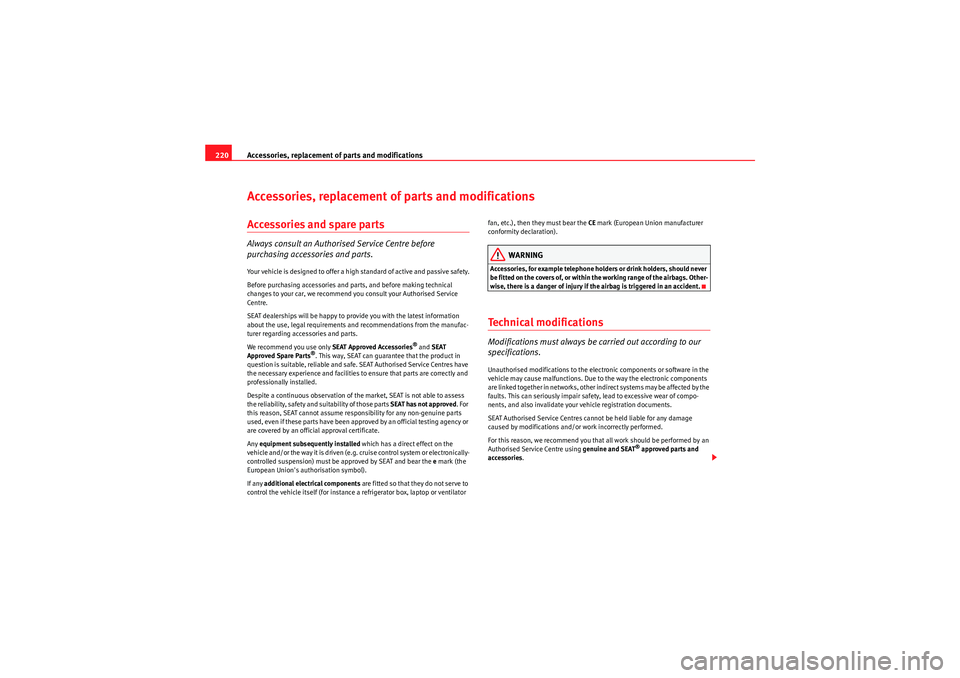
Accessories, replacement of parts and modifications
220Accessories, replacement of parts and modificationsAccessories and spare partsAlways consult an Authorised Service Centre before
purchasing accessories and parts.Your vehicle is designed to offer a high standard of active and passive safety.
Before purchasing accessories and parts, and before making technical
changes to your car, we recommend you consult your Authorised Service
Centre.
SEAT dealerships will be happy to provide you with the latest information
about the use, legal requirements and recommendations from the manufac-
turer regarding accessories and parts.
We recommend you use only SEAT Approved Accessories
® and SEAT
Approved Spare Parts
®. This way, SEAT can guarantee that the product in
question is suitable, reliable and safe. SEAT Authorised Service Centres have
the necessary experience and facilities to ensure that parts are correctly and
professionally installed.
Despite a continuous observation of the market, SEAT is not able to assess
the reliability, safety and suitability of those parts SEAT has not approved. For
this reason, SEAT cannot assume responsibility for any non-genuine parts
used, even if these parts have been approved by an official testing agency or
are covered by an official approval certificate.
Any equipment subsequently installed which has a direct effect on the
ve hi cle a nd/ or the way i t is d ri ve n ( e. g. cr u is e co ntrol s ys te m o r e lec tro ni ca lly-
controlled suspension) must be approved by SEAT and bear the e mark (the
European Union's authorisation symbol).
If any additional electrical components are fitted so that they do not serve to
control the vehicle itself (for instance a refrigerator box, laptop or ventilator fan, etc.), then they must bear the
CE mark (European Union manufacturer
conformity declaration).
WARNING
Accessories, for example telephone holders or drink holders, should never
be fitted on the covers of, or within the working range of the airbags. Other-
wise, there is a danger of injury if the airbag is triggered in an accident.Technical modificationsModifications must always be carried out according to our
specifications.Unauthorised modifications to the electronic components or software in the
vehicle may cause malfunctions. Due to the way the electronic components
are linked together in networks, other indirect systems may be affected by the
faults. This can seriously impair safety, lead to excessive wear of compo-
nents, and also invalidate your vehicle registration documents.
SEAT Authorised Service Centres cannot be held liable for any damage
caused by modifications and/or work incorrectly performed.
For this reason, we recommend you that all work should be performed by an
Authorised Service Centre using genuine and SEAT
® approved parts and
accessories .
ExeoST_EN.book Seite 220 Donnerstag, 3. September 2009 12:24 12
Page 231 of 316
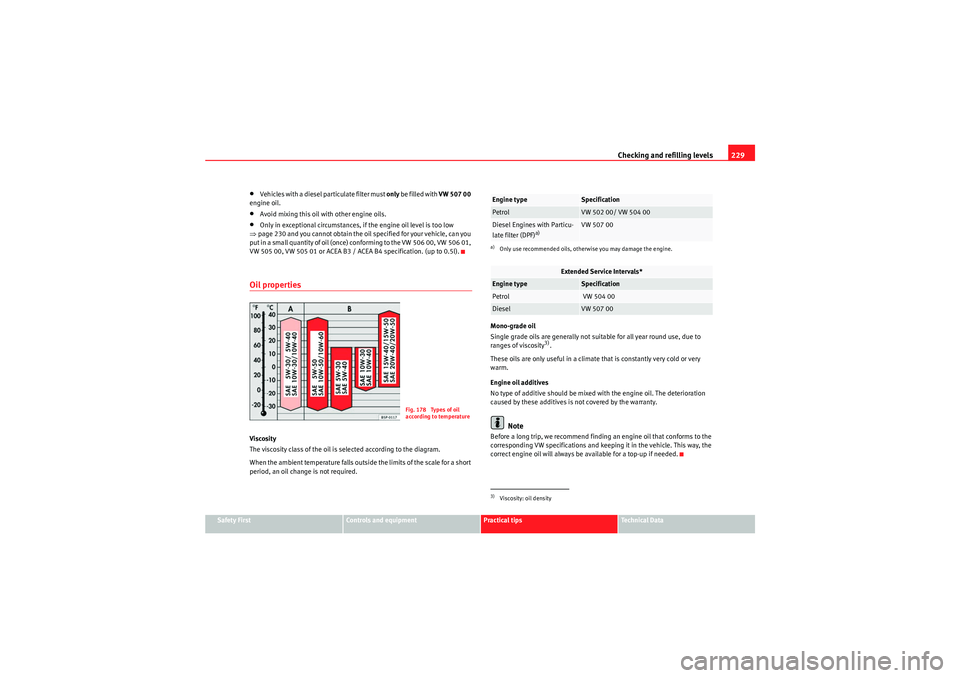
Checking and refilling levels229
Safety First
Controls and equipment
Practical tips
Technical Data
•Vehicles with a diesel particulate filter must only b e fille d with VW 507 00
engine oil.•Avoid mixing this oil with other engine oils.•Only in exceptional circumstances, if the engine oil level is too low
⇒ page 230 and you cannot obtain the oil specified for your vehicle, can you
put in a small quantity of oil (once) conforming to the VW 506 00, VW 506 01,
VW 505 00, VW 505 01 or ACEA B3 / ACEA B4 specification. (up to 0.5l).Oil propertiesViscosity
The viscosity class of the oil is selected according to the diagram.
When the ambient temperature falls outside the limits of the scale for a short
period, an oil change is not required. Mono-grade oil
Single grade oils are generally not suitable for all year round use, due to
ranges of viscosity
3).
These oils are only useful in a climate that is constantly very cold or very
warm.
Engine oil additives
No type of additive should be mixed with the engine oil. The deterioration
caused by these additives is not covered by the warranty.
Note
Before a long trip, we recommend finding an engine oil that conforms to the
corresponding VW specifications and keeping it in the vehicle. This way, the
correct engine oil will always be available for a top-up if needed.
Fig. 178 Types of oil
according to temperature
Engine type
Specification
Petrol
VW 502 00/ VW 504 00
Diesel Engines with Particu-
late filter (DPF)
a)
a)Only use recommended oils, otherwise you may damage the engine.
VW 507 00
Extended Service Intervals*
Engine type
Specification
Petrol
VW 504 00
Diesel
VW 507 00
3)Viscosity: oil density
ExeoST_EN.book Seite 229 Donnerstag, 3. September 2009 12:24 12
Page 235 of 316
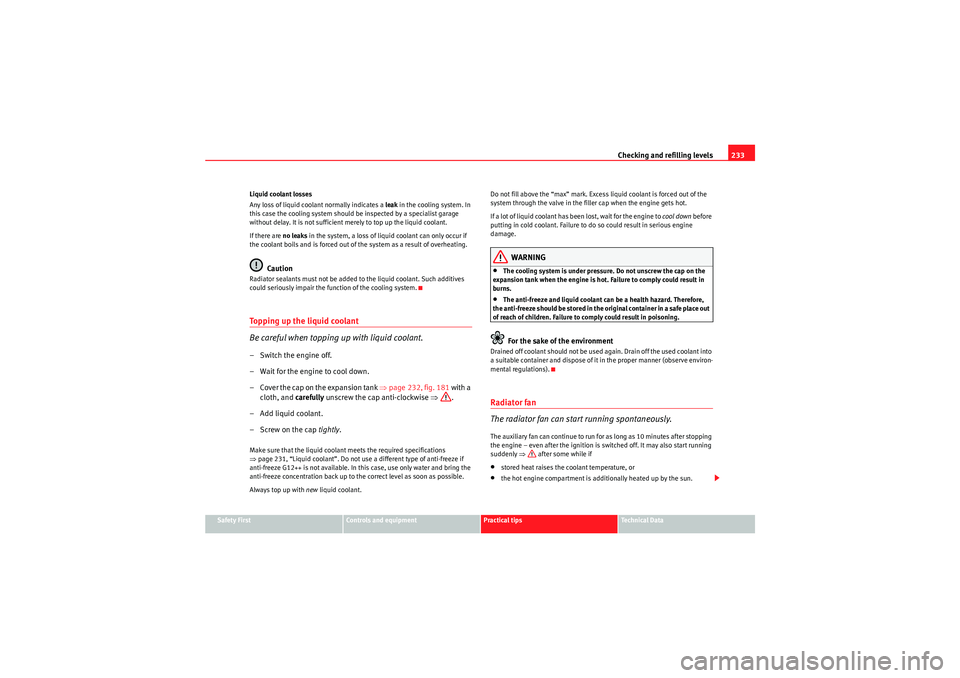
Checking and refilling levels233
Safety First
Controls and equipment
Practical tips
Technical Data
Liquid coolant losses
Any loss of liquid coolant normally indicates a
leak in the cooling system. In
this case the cooling system should be inspected by a specialist garage
without delay. It is not sufficient merely to top up the liquid coolant.
If there are no leaks in the system, a loss of liquid coolant can only occur if
the coolant boils and is forced out of the system as a result of overheating.
Caution
Radiator sealants must not be added to the liquid coolant. Such additives
could seriously impair the function of the cooling system.Topping up the liquid coolant
Be careful when topping up with liquid coolant.– Switch the engine off.
– Wait for the engine to cool down.
– Cover the cap on the expansion tank ⇒page 232, fig. 181 with a
cloth, and carefully unscrew the cap anti-clockwise ⇒.
– Add liquid coolant.
– Screw on the cap tightly.Make sure that the liquid coolant meets the required specifications
⇒page 231, “Liquid coolant”. Do not use a different type of anti-freeze if
anti-freeze G12++ is not available. In this case, use only water and bring the
anti-freeze concentration back up to the correct level as soon as possible.
Always top up with new liquid coolant. Do not fill above the “max” mark. Excess liquid coolant is forced out of the
system through the valve in the filler cap when the engine gets hot.
If a lot of liquid coolant has been lost, wait for the engine to
cool down before
putting in cold coolant. Failure to do so could result in serious engine
damage.
WARNING
•The cooling system is under pressure. Do not unscrew the cap on the
expansion tank when the engine is hot. Failure to comply could result in
burns.•The anti-freeze and liquid coolant can be a health hazard. Therefore,
the anti-freeze should be stored in the original container in a safe place out
of reach of children. Failure to comply could result in poisoning.For the sake of the environment
Drained off coolant should not be used again. Drain off the used coolant into
a suitable container and dispose of it in the proper manner (observe environ-
mental regulations).Radiator fan
The radiator fan can start running spontaneously.The auxiliary fan can continue to run for as long as 10 minutes after stopping
the engine – even after the ignition is switched off. It may also start running
suddenly ⇒ after some while if•stored heat raises the coolant temperature, or•the hot engine compartment is additionally heated up by the sun.
ExeoST_EN.book Seite 233 Donnerstag, 3. September 2009 12:24 12
Page 241 of 316

Checking and refilling levels239
Safety First
Controls and equipment
Practical tips
Technical Data
Winter operations
The battery is drained more in cold weather, which means that the starting
power is reduced. For this reason, have the battery checked and charged if
necessary before the start of winter.
Replacing the battery
A replacement battery
must have the same capacity, voltage and current
rating. It must also have the same dimensions as the original, factory-fitted
battery and have sealed caps. The SEAT batteries which have been specially
developed fulfil the maintenance, performance and safety specifications for
your vehicle.
We recommend you use maintenance-free batteries.
WARNING
•All work on batteries requires specialist knowledge. If work is required
on the battery, this should be performed by a Technical Service or
specialist garage. Danger of caustic burns and explosion!•The battery must not be opened. Never try to change the battery's
liquid level. Explosive gas is released from the battery that could lead to an
explosion.Caution
•The battery holder and clamps must always be correctly secured.•Before starting any work on the battery, always observe the warnings
listed under ⇒.For the sake of the environment
Batteries contain toxic substances including sulphuric acid and lead.
Therefore, they must be disposed in line with environmental regulations and
must not be disposed of with ordinary household waste. Make sure discon-
nected batteries cannot tip over. Sulphuric acid could be spilt!
Important safety warnings for handling a car batteryThe battery is located at the back of the engine compartment ⇒ page 295.
WARNING
Always be aware of the danger of injury and chemical burns as well as the
risk of accident or fire when working on the battery and the electrical
system:•Wear eye protection. Protect your eyes, skin and clothing from acid and
particles containing lead.•Battery acid is very corrosive and caustic. Wear protective gloves and
eye protection. Do not tilt the batteries. This could spill acid through the
vents. Rinse battery acid from eyes immediately for several minutes with
clear water. Then seek medical care immediately. Neutralize any acid
splashes on the skin or clothing with a soapy solution, and rinse off with
plenty of water. If acid is swallowed by mistake, consult a doctor immedi-
ately.•Fires, sparks, naked lights and smoking are prohibited. When handling
cables and electrical equipment, avoid causing sparks and electrostatic
charge. Never short the battery terminals. High-energy sparks can cause
injury.
Wear eye protection
Battery acid is very corrosive and caustic. Wear protective
gloves and eye protection!
Fires, sparks, naked lights and smoking are prohibited!
A highly explosive mixture of gases is released when the batter y
is under charge.
Keep children away from acid and batteries!
ExeoST_EN.book Seite 239 Donnerstag, 3. September 2009 12:24 12
Page 298 of 316

Technical Data
296Petrol engine 1.6l 75 kW (102 HP)Engine specifications
Performance figures
Weights
Trailer weights Power output in kW (HP)
rpm 75 (102) / 5600
Maximum torque in Nm at 1/min 148 / 3800
No. of cylinders/ capacity in cm
3
4 / 1595
Fuel Super 95 RON
a)/Normal 91 RON
b)
a)Research- Octane- Number = Measure of the antidetonator petrol power.b)Slight power lossMaximum speed in km/h 186
Acceleration from 0-80 km/h in seconds 8,9
Acceleration from 0-100 km/h in seconds 13,1
Gross vehicle weight in kg 1930
Weight in running order (with driver) in kg 1445
Gross front axle weight in kg 990
Gross rear axle weight in kg 1070
Permitted roof load in kg 75
Trailer without brakes 720
Trailer with brakes, gradients up to 8% 1400
Trailer with brakes, gradients up to 12% 1200
ExeoST_EN.book Seite 296 Donnerstag, 3. September 2009 12:24 12
Page 299 of 316

Technical Data297
Safety First
Controls and equipment
Practical tips
Technical Data
Engine oil capacity
Petrol engine 1.8l 110 kW (150 HP)Engine specifications
Performance figures
Weights
Approximate engine oil capacity with oil filter change
3.6 litres
Power output in kW (HP) rpm 110 (150) / 5700
Maximum torque in Nm at rpm 220 / 1800
No. of cylinders/ capacity in cm
3
4 / 1781
Fuel Super 98 RON
a)/Super 95 RON
b)
a)Research- Octane- Number = Measure of the antidetonator petrol power.b)Slight power loss.Maximum speed in km/h 210
Acceleration from 0-80 km/h in seconds 6,6
Acceleration from 0-100 km/h in seconds 9,6
Gross vehicle weight in kg 2020
Weight in working order (with driver) in kg 1535
Gross front axle weight in kg 1065
Gross rear axle weight in kg 1085
Permitted roof load in kg 75
ExeoST_EN.book Seite 297 Donnerstag, 3. September 2009 12:24 12
Page 300 of 316
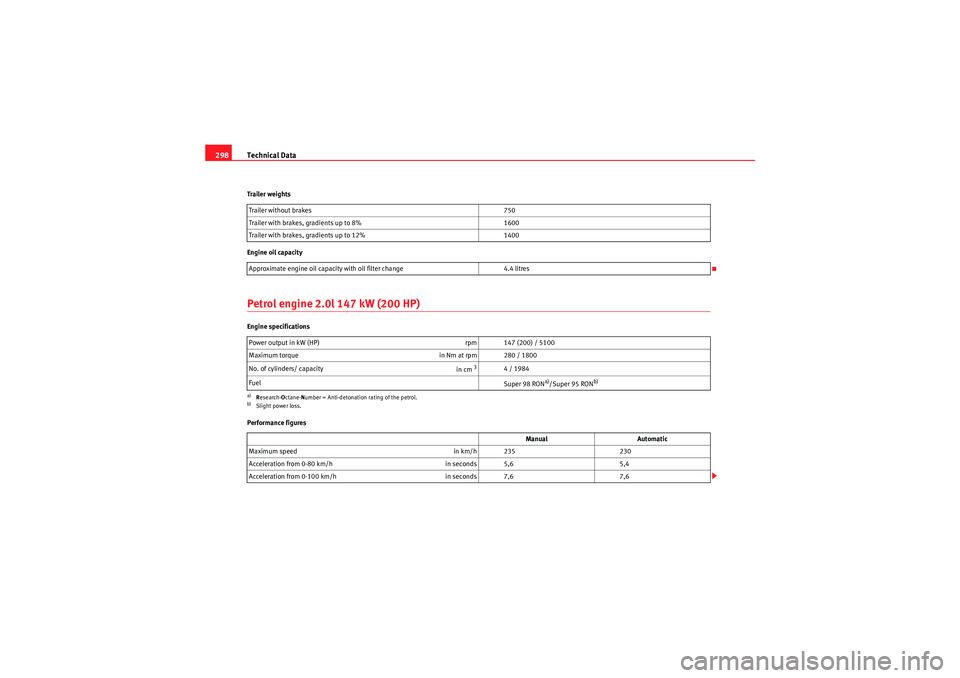
Technical Data
298Trailer weights
Engine oil capacityPetrol engine 2.0l 147 kW (200 HP)Engine specifications
Performance figures Trailer without brakes
750
Trailer with brakes, gradients up to 8% 1600
Trailer with brakes, gradients up to 12% 1400
Approximate engine oil capacity with oil filter change 4.4 litres
Power output in kW (HP) rpm 147 (200) / 5100
Maximum torque in Nm at rpm 280 / 1800
No. of cylinders/ capacity in cm
3
4 / 1984
Fuel Super 98 RON
a)/Super 95 RON
b)
a)Research- Octane- Number = Anti-detonation rating of the petrol.b)Slight power loss.
Manual Automatic
Maximum speed in km/h 235230
Acceleration from 0-80 km/h in seconds 5,65,4
Acceleration from 0-100 km/h in seconds 7,67,6
ExeoST_EN.book Seite 298 Donnerstag, 3. September 2009 12:24 12
Page 301 of 316
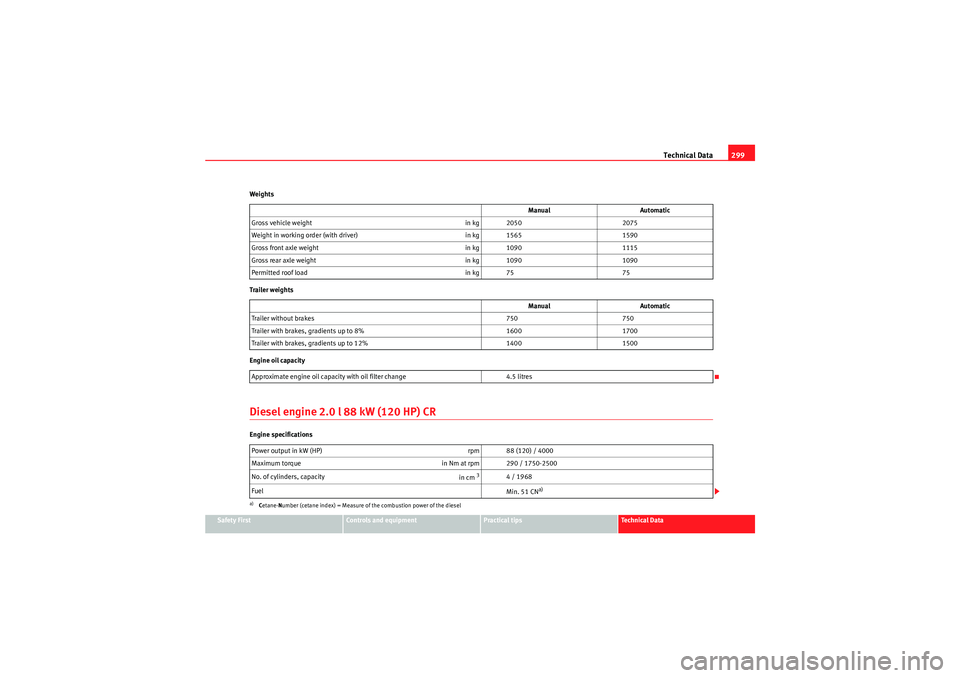
Technical Data299
Safety First
Controls and equipment
Practical tips
Technical Data
Weights
Trailer weights
Engine oil capacity
Diesel engine 2.0 l 88 kW (120 HP) CREngine specifications
Manual
Automatic
Gross vehicle weight in kg 20502075
Weight in working order (with driver) in kg 15651590
Gross front axle weight in kg 10901115
Gross rear axle weight in kg 10901090
Permitted roof load in kg 7575
Manual Automatic
Trailer without brakes 750750
Trailer with brakes, gradients up to 8% 16001700
Trailer with brakes, gradients up to 12% 14001500
Approximate engine oil capacity with oil filter change 4.5 litres
Power output in kW (HP) rpm 88 (120) / 4000
Maximum torque in Nm at rpm 290 / 1750-2500
No. of cylinders, capacity in cm
3
4 / 1968
Fuel Min. 51 CN
a)
a)Cetane- Number (cetane index) = Measure of the combustion power of the diesel
ExeoST_EN.book Seite 299 Donnerstag, 3. September 2009 12:24 12
Page 303 of 316
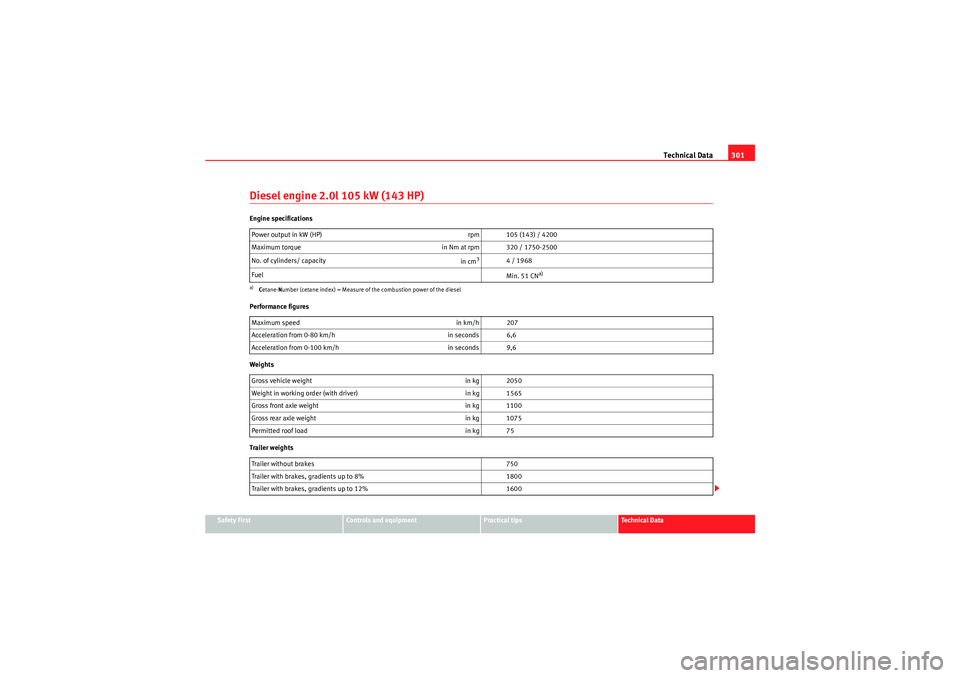
Technical Data301
Safety First
Controls and equipment
Practical tips
Technical Data
Diesel engine 2.0l 105 kW (143 HP)Engine specifications
Performance figures
Weights
Trailer weightsPower output in kW (HP)
rpm 105 (143) / 4200
Maximum torque in Nm at rpm 320 / 1750-2500
No. of cylinders/ capacity in cm
3
4 / 1968
Fuel Min. 51 CN
a)
a)Cetane- Number (cetane index) = Measure of the combustion power of the dieselMaximum speed in km/h 207
Acceleration from 0-80 km/h in seconds 6,6
Acceleration from 0-100 km/h in seconds 9,6
Gross vehicle weight in kg 2050
Weight in working order (with driver) in kg 1565
Gross front axle weight in kg 1100
Gross rear axle weight in kg 1075
Permitted roof load in kg 75
Trailer without brakes 750
Trailer with brakes, gradients up to 8% 1800
Trailer with brakes, gradients up to 12% 1600
ExeoST_EN.book Seite 301 Donnerstag, 3. September 2009 12:24 12
Page 304 of 316
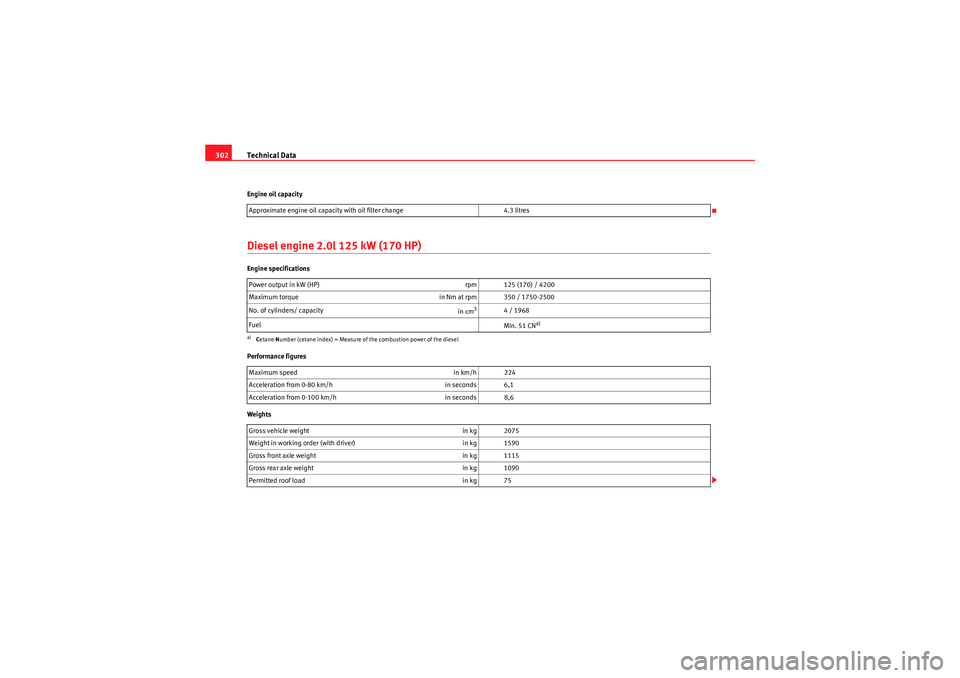
Technical Data
302Engine oil capacityDiesel engine 2.0l 125 kW (170 HP)Engine specifications
Performance figures
Weights Approximate engine oil capacity with oil filter change
4.3 litres
Power output in kW (HP) rpm 125 (170) / 4200
Maximum torque in Nm at rpm 350 / 1750-2500
No. of cylinders/ capacity in cm
3
4 / 1968
Fuel Min. 51 CN
a)
a)Cetane- Number (cetane index) = Measure of the combustion power of the dieselMaximum speed in km/h 224
Acceleration from 0-80 km/h in seconds 6,1
Acceleration from 0-100 km/h in seconds 8,6
Gross vehicle weight in kg 2075
Weight in working order (with driver) in kg 1590
Gross front axle weight in kg 1115
Gross rear axle weight in kg 1090
Permitted roof load in kg 75
ExeoST_EN.book Seite 302 Donnerstag, 3. September 2009 12:24 12